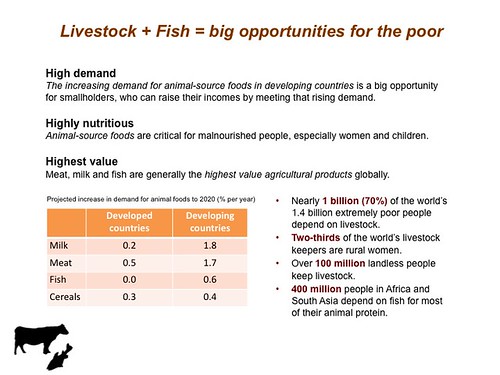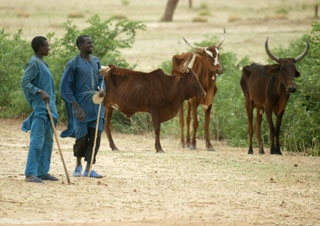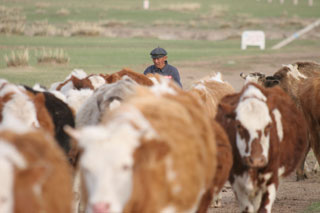ILRI’s Director General Carlos Seré addresses talks held by African ministers responsible for animal resources in Kigali, Rwanda.
Keynote address by Carlos Seré, Director General of the
INTERNATIONAL LIVESTOCK RESEARCH INSTITUTE
Unleashing the Potential of Livestock
to Make Poverty History in Africa
(Salutations)
It is my privilege and pleasure to speak to you today on historic changes in the livestock sector and innovations that can help us create a new future for livestock producers, marketers and consumers.
The livestock sub-sector is one of the most dynamic in the world – growing at well over 7 percent per year in developing countries over the last 25 years and far out-performing virtually all other agricultural and industrial commodities. This growth is driven by soaring demand for meat and milk in developing countries. Every year, developing-country consumers add an additional US$20 billion to their already high levels of collective spending on livestock foods such as milk and meat.
On the negative side, the threat of – and response to – resurgent and emerging diseases, particularly those transmitted between livestock and people, is also changing the livestock sector: Witness the massive media and political attention currently being paid to avian influenza worldwide.
This dynamic situation presents both immense challenges and opportunities for Africa. If the challenges are met and the opportunities seized, there is no doubt that livestock can be a powerful development tool in Africa: the livestock sector can help ‘make poverty history’.
We know that 70 percent of the rural poor in Africa keep livestock and that some 200 million people on this continent rely on livestock for their livelihoods. Despite the importance of livestock to the poor, however, the sector needs to transform itself to realize its full potential as a development tool.
The rising demand for livestock products in developing countries – driven by increasing urbanization and associated dietary changes – is predicted to continue in the coming decades. In Africa producers are struggling to keep up with this growing demand. FAO calculations suggest that without major changes in production levels, by 2015 Africa will be a significant net importer of all livestock food products, except mutton/goat meat.
Given the surging demand patterns, especially in the Near East and Asia, many believe that increased trade is the key to the future development of Africa’s livestock sector. But export of livestock products, whether to neighbouring countries, regional partners or more distant global markets, presents its own challenges, especially in regard to meeting food safety standards and controlling diseases of trade – the theme of this week’s conference.
Smallholders remain the backbone of Africa’s livestock sector but the requirement to meet more stringent food quality and safety standards – both in domestic and export markets – will undoubtedly bring about changes in livestock commodity value chains. Will Africa’s smallholder farmers evolve into or be absorbed by large-scale ‘vertically integrated’ commercial operations; will they be able to organize themselves into efficient, competitive producer associations or will the costs and difficulties of meeting these higher sanitary and food safety standards force them out of the value chains altogether? And what impact will rising food safety standards have on the poorest consumers – will the cost of compliance put livestock products beyond their reach?
Clearly, the livestock sector in Africa has many challenges. But there are also creative, inspiring, bold initiatives that offer real possibilities of meeting those challenges. And increasingly these initiatives are being developed and led in Africa, by Africa and for Africa.
Recognizing the critical role of livestock in the livelihoods of rural communities, African ministers of agriculture specifically requested that the livestock sub-sector be given adequate
attention within NEPAD’s activities. This has led to the development of a companion document to the existing Comprehensive Africa Agriculture Development Plan, CAADP II, which will be/has been formally presented to you this week.
In addition, the African Union Commission has adopted the Africa Livestock Initiative (ALive) as a platform for the implementation of its livestock development programmes. As you know, ALive is an initiative of the World Bank launched in May 2004 to build a sustainable livestock sector to reduce poverty and stimulate economic growth in Africa.
Also under the aegis of the AU, PATTEC, the Pan-African Tsetse and Trypanosomosis Eradication Campaign, is a bold – some would say audacious – initiative to rid the entire continent of the scourge of trypanosomosis, one of the biggest constraints to improving cattle production over much of Africa. Decisive political action in this regard now needs to be supported by bringing to bear the vast body of research knowledge on tsetse fly control. It is imperative that PATTEC builds on this knowledge and bases its approach on good science.
Research has a vital role to play in the livestock sector – but research needs to be organized and managed in a new way.
Research priorities need to be identified based on dialogue with all stakeholders, from ministers of livestock to livestock keepers and consumers. Supply-led research agendas do not work in a demand-driven world.
Research needs to be undertaken through far broader, more inclusive ‘smart’ partnerships. International agricultural research centres, such as ILRI, have an increasingly facilitative role to play in partnerships formed among national agricultural research systems, state veterinary services, the private sector, non-governmental organizations, vaccine production units and farmer associations.
Beyond research, international regulatory and technical assistance agencies such as OIE and FAO have a vital role to play in addressing Africa’s needs for building regulatory and institutional capacity. Similarly, the capacity of African livestock scientists needs to be raised to enable them to better meet the many challenges the sector is posing.
The power of ‘new science’, especially biosciences such as genomics and proteomics, needs to be brought to bear on African livestock problems. The OIE regional meeting in Khartoum recognized this when, in February 2004, it emphasized the role of biotechnology. But new science is expensive and so new ways need to be found to allow access to the facilities and resources needed.
The New Partnership for African’s Development has placed agriculture and science at the forefront of Africa’s economic development, and NEPAD has played a leading role in the establishment of what is envisioned to be the first of a series of regional centres of excellence – Biosciences eastern and central Africa (BecA).
Based at ILRI, BecA is an exciting example of a new institutional paradigm for African-led research. Established at a cost of US$25 million, BecA will enable African scientists to access state-of-the-art bioscience facilities. Its vision is to enable African scientists and institutions to become significant technological innovators – not just technology users – by undertaking bioscience research targeted at priority constraints affecting Africa agriculture, including the livestock sector. Access to world-class facilities will also engage African scientists currently in the Diaspora and encourage them to carry out research for Africa, at the same time enabling young and upcoming African scientists to achieve their full potential without going overseas, thus avoiding a future brain drain.
But research isn’t just about developing new technologies – better breeds and vaccines will help but technology alone will not be the answer. Complementary research is vital, for example, to facilitate the development of processes, policies, and institutions that both maximize Africa’s gain from new opportunities worldwide and help ensure that these gains are widely spread for development and political stability.
The Smallholder Dairy Programme in Kenya, for example, showed that while pasteurized milk met the needs of the wealthy, the ban on marketing of raw milk was damaging to small-scale producers, traders and poor consumers, and the perceived risk associated with this trade was grossly overstated as Kenyans consume nearly all their milk after boiling it to make tea – which destroys potentially dangerous pathogens. The Smallholder Dairy Programme is a good example of how research should be done: broad inclusive partnerships tackling high-priority problems and packaging and presenting independent research findings to enable them to be used by a range of stakeholders, including by policy makers so that they can develop better evidence-based policies.
In conclusion: there are pressing problems and challenges facing the livestock sector in Africa – and new challenges will arise in the future. Better policies, institutions, regulatory frameworks and technologies are all needed.
More investment is also required: national agriculture research systems in Africa have been under-funded for the past several decades. African governments now need to deliver on their commitment, made at Maputo in 2003, to allocate 10 percent of national budgetary resources for the implementation of the CAADP action plans.
CAADP II notes that to increase institutional effectiveness of research there is a need for greater cooperation and collaboration, on a regional basis, to tackle prioritized research aimed at increasing production and productivity in the livestock sector. It goes on to note that national agricultural research systems need to collaborate more effectively with international research centres such as ILRI.
As director general of ILRI, I assure you we are ready to collaborate with African governments, regional organizations, national agricultural research systems and other stakeholders in livestock research for development. Together, we can manage and target African livestock research to meet the challenges and exploit the opportunities the livestock sector presents.








